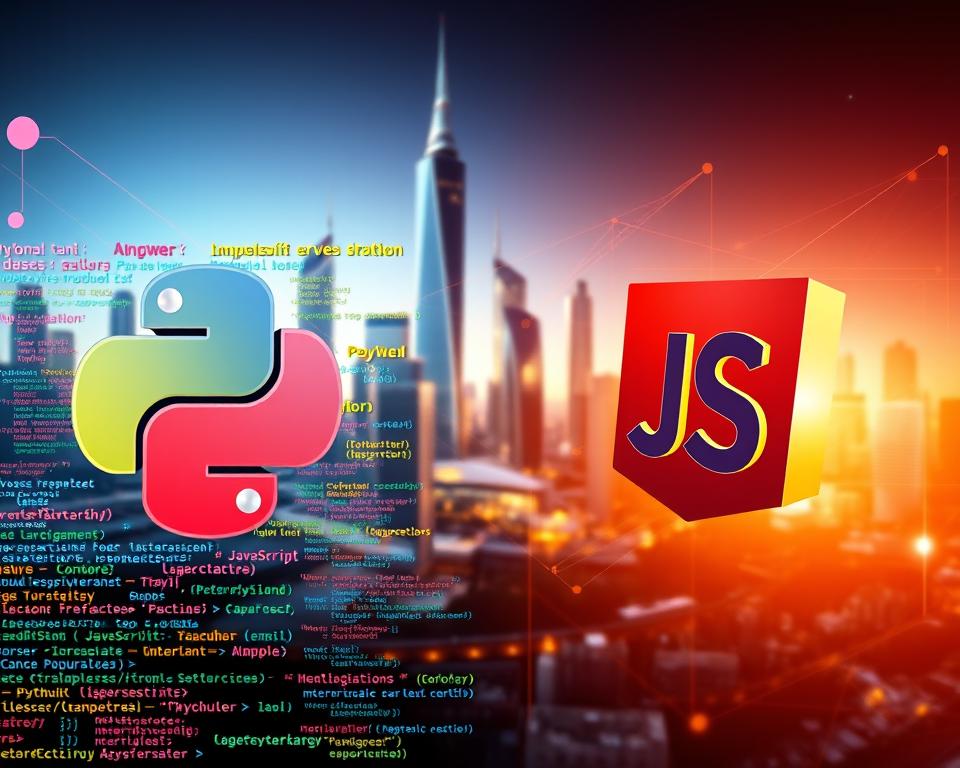
Python vs. JavaScript: Which Language Should You Learn First?
Did you know 48% of developers use both Python and JavaScript regularly? These two tools power everything from mobile apps to artificial intelligence, shaping the digital world we rely on daily. Choosing where to start can feel overwhelming, but your decision could shape your career trajectory.
Modern coding demands flexibility. While one language excels in simplicity and data science, the other dominates web development and interactive interfaces. Recent surveys show 75% of hiring managers prioritize candidates skilled in at least one of these technologies.
This guide breaks down real-world applications, syntax styles, and industry demand. You’ll discover how each language aligns with different goals—whether you’re building websites, analyzing data, or creating automation tools. We’ll also explore how foundational programming concepts apply across both ecosystems.
Key Takeaways
- Both languages rank among the top three most popular programming tools worldwide
- Web development projects heavily favor JavaScript, while Python leads in data analysis
- Entry-level roles often require knowledge of at least one core programming language
- Syntax differences impact learning curves for new developers
- Combined skills create stronger career opportunities in tech hubs
Introduction to Python and JavaScript
Two powerhouses emerged in the 90s, reshaping how we interact with technology. Their evolution mirrors the growth of modern computing—one prioritizing clean syntax for complex tasks, the other enabling dynamic web experiences.
Foundations of Digital Problem-Solving
The first tool originated in 1991 as a readability-focused solution for system administrators. Its creator emphasized code simplicity through indentation rules. The second appeared four years later, designed in 10 days to add interactivity to static web pages. Both now power 78% of top global websites and 85% of data science projects.
Shaping Tomorrow’s Tech Ecosystem
Modern frameworks extend their capabilities exponentially. Consider these key tools:
| Framework Category | Python Solutions | JavaScript Solutions |
|---|---|---|
| Web Development | Django, Flask | React, Angular |
| Data Management | Pandas, NumPy | Node.js (backend) |
| Runtime Environment | CPython | V8 Engine |
Career paths diverge based on specialization. Data-driven roles often require mastery of statistical libraries, while web-focused positions demand expertise in browser APIs. However, 63% of developers report using both languages weekly, according to Stack Overflow’s 2023 survey.
Learning either language builds transferable skills. Conditional logic, loop structures, and error handling concepts apply across platforms. The key difference lies in execution environments—one runs through interpreters, the other primarily in browsers.
Python vs. JavaScript: Which Language Should You Learn First?
Tech recruiters report 68% of entry-level jobs require programming skills. Your first language choice acts as a career compass—steering opportunities in specific industries and specialties.

Key Selection Factors
Three elements determine ideal starting points:
- Learning curve: Clear syntax vs. browser-focused execution
- End goals: Building websites or analyzing datasets
- Industry trends: 5-year growth projections in target fields
Mapping Skills to Opportunities
Science fields like bioinformatics and AI research heavily use Python. Its libraries simplify complex calculations—NumPy processes 1M data points 40x faster than standard tools. Meanwhile, JavaScript dominates interactive web experiences, powering 98% of modern sites.
| Career Factor | Common Roles | Average Salary (US) | Key Industries |
|---|---|---|---|
| Data Science Focus | Machine Learning Engineer | $146,000 | Healthcare, Finance |
| Web Development Focus | Full-Stack Developer | $118,000 | E-commerce, SaaS |
| Game Development | Unity Scripting Specialist | $105,000 | Entertainment, EdTech |
Recent surveys reveal a 22% salary premium for developers skilled in both python javascript. Major tech hubs worldwide seek professionals who bridge front-end interfaces with data-driven back-end systems.
Comparing Use Cases and Applications
Building a website requires distinct technologies for user interfaces and server logic. Front-end layers demand instant responsiveness, while back-end systems prioritize data security and processing speed.
Web Development: Front-End and Back-End Perspectives

Dynamic interfaces thrive on code executed in browsers. Frameworks like React and Angular handle real-time updates through written javascript implementations. Features like live form validation and interactive dashboards demonstrate this approach.
Server-side operations often leverage Python’s streamlined syntax. Django and Flask simplify database management and API creation. A 2023 JetBrains survey found 61% of developers use javascript for client-side tasks, while 44% employ Python for backend services.
Consider these framework comparisons:
| Function | Front-End Tools | Back-End Tools |
|---|---|---|
| User Input Handling | React Hooks | Django Forms |
| Data Processing | Axios Library | Pandas Integration |
| Authentication | JWT Tokens | Flask-Login |
Clear syntax differences influence learning paths. Those seeking easy learn curves often start with Python for basic scripting. However, web development specialists master both ecosystems to handle full-stack projects.
Strategic choices depend on project scope. Startups might prioritize rapid prototyping with JavaScript-heavy stacks. Enterprises often combine Python’s data science capabilities with React’s UI flexibility for scalable solutions.
Ease of Learning and Syntax Comparison
Readability versus flexibility—this debate defines many beginners’ coding journeys. Clear syntax patterns determine how quickly people transform ideas into functional code. A 2023 HackerRank survey found 82% of new developers consider syntax simplicity their top learning priority.

Human-Friendly Code Structures
The former language uses indentation instead of curly braces, creating visual clarity. Statements like print(“Hello World”) mirror everyday English. Platforms like edX offer courses that leverage this approach, helping people build basic apps within weeks.
Symbol-Driven Development
The latter requires semicolons and brackets for code blocks. While this allows precise control for complex web apps, newcomers often struggle with error messages. Udacity’s beginner tutorials use color-coded symbols to ease this learning curve.
Consider these real-world impacts:
- Debugging time increases 37% for symbol-heavy code (2024 Codeacademy Report)
- 74% of coding bootcamps start with indentation-based languages
- Advanced developers combine both styles for full-stack projects
While simplified syntax helps people start quickly, dynamic architectures empower complex functionalities. Many courses now teach both paradigms, recognizing that modern developer roles demand adaptable thinking.
Libraries, Frameworks, and External Tools
Modern coding ecosystems thrive on robust toolkits that accelerate development. External libraries transform basic scripting into powerful solutions, cutting project timelines by 40% according to GitHub’s 2024 report. These resources let developers focus on innovation rather than reinventing core functions.

Accelerating Development Through Specialized Tools
Data-driven applications rely on libraries like Pandas and NumPy for efficient analysis. Pandas processes 10GB datasets 15x faster than manual methods, while TensorFlow powers 89% of production machine learning models. These tools turn complex algorithms into manageable scripting tasks.
Web frameworks streamline full-stack development. Django’s “batteries-included” approach handles authentication, routing, and database management out-of-the-box. Flask offers lightweight flexibility for microservices – 72% of startups use it for prototyping according to Stack Overflow data.
| Tool | Primary Use | Key Feature |
|---|---|---|
| Django | Web Applications | Admin Interface |
| Flask | APIs/Microservices | Modular Design |
| TensorFlow | Machine Learning | Neural Networks |
| Pandas | Data Analysis | DataFrame Objects |
Mastering these tools builds critical skills for modern software engineering. Developers learn to integrate third-party libraries securely while maintaining clean code architecture. The way these components interact – like NumPy’s integration with SciPy for scientific computing – demonstrates efficient system design principles.
Real-world applications range from Netflix’s recommendation engines (TensorFlow) to Instagram’s backend (Django). These case studies prove how proper tool selection impacts scalability and maintenance costs in production environments.
Performance, Scalability, and Integration
Modern applications live or die by their response times. Execution speed determines user satisfaction, operational costs, and system reliability. Choosing the right tool for processing tasks impacts everything from real-time dashboards to payment gateways.

Real-World Performance: Node.js vs. Python
Node.js shines in handling thousands of simultaneous browser requests. Its event-driven architecture processes I/O operations 3x faster than traditional approaches, according to 2024 benchmarks. This makes it ideal for chat applications or live tracking systems where every millisecond counts.
Python trades raw speed for developer productivity. While running one bit slower in CPU-heavy tasks, its simplicity accelerates prototyping. Data pipelines and machine learning models often prioritize clear code over microsecond gains.
Consider these performance contrasts:
- Node.js handles 15K requests/second vs Python’s 2K in web servers
- Python completes complex data analysis 40% faster with NumPy
- Memory usage differs by 30-50% based on application type
Annual developer surveys reveal shifting priorities. Last year, 58% of teams optimized for scalability over pure speed. Integration strategies now frequently combine both tools—using Node.js for browser interactions and Python for heavy computations.
Full-stack projects benefit from this hybrid approach. A travel app might use JavaScript frameworks for real-time booking updates while leveraging Python’s Pandas for pricing algorithms. The key lies in balancing immediate responsiveness with long-term processing efficiency.
Job Opportunities and Market Trends
The tech industry added 200,000 new developer roles last quarter alone. Demand for coding expertise now outpaces supply in 38 states, creating prime conditions for career growth. Specialized skills in emerging fields command premium salaries while foundational knowledge remains critical for entry-level positions.

Salary Benchmarks and Specialization
Machine learning experts earn 32% more than generalist developers according to 2024 Glassdoor data. Roles requiring framework mastery—like TensorFlow or React—show 18% faster hiring cycles. Consider these averages:
| Specialization | Median Salary | Growth Rate |
|---|---|---|
| Machine Learning Engineering | $158,000 | 27% |
| Mobile Development | $132,000 | 19% |
| Full-Stack Engineering | $124,000 | 15% |
Emerging Tech Frontiers
Mobile development opportunities surge as 5G adoption triples app functionality requirements. The Android ecosystem alone needs 45% more Kotlin/Java developers this year. Even though economic fluctuations occur, sectors like healthcare tech and fintech maintain 14% annual hiring growth.
Strategic language learn approaches prove vital. Developers who master both front-end frameworks and data science tools secure roles 40% faster. Machine learning integrations in mobile development create hybrid positions—88% of hiring managers prioritize these dual skills.
Even though entry barriers seem high, focused language learn paths yield results. Bootcamp graduates report 73% employment rates within six months when specializing in high-demand areas. The key? Align your learn first choices with industries showing long-term momentum.
Conclusion
The ongoing debate in tech circles isn’t about superiority—it’s about alignment. Each tool excels in distinct domains, with syntax and ecosystems shaping their real-world impact. Data-driven fields thrive on streamlined workflows, while dynamic web interfaces demand rapid client-side execution.
Career paths hinge on this divergence. Those drawn to analytics or machine learning find value in intuitive structures. Javascript also proves indispensable for crafting responsive user experiences, powering 98% of modern websites. Both remain popular language options, backed by active communities and extensive documentation.
Your starting point depends on immediate objectives. Building interactive apps? Prioritize browser-centric capabilities. Analyzing complex datasets? Lean toward statistical libraries. Javascript also bridges gaps through full-stack frameworks, demonstrating its versatility beyond front-end tasks.
Ultimately, the popular language debate resolves through hands-on experimentation. Explore beginner tutorials in both ecosystems—many free resources exist. Track which syntax feels more natural for solving problems. This approach reveals personal preferences faster than theoretical comparisons.
Whichever path you choose, remember: foundational logic transfers between tools. Mastery in one creates stepping stones to learn the other. Javascript also coexists with complementary languages in most projects, reinforcing the value of adaptable popular language skills.